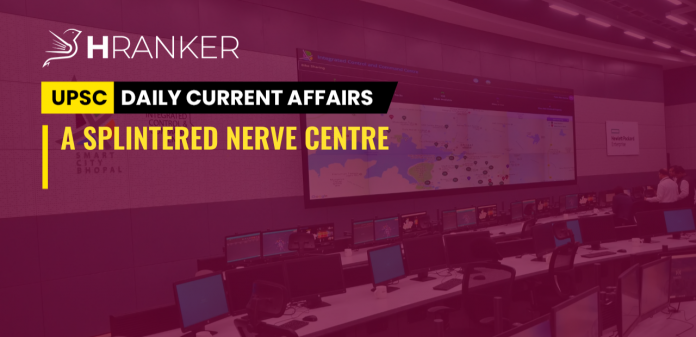WHAT’S IN NEWS:
The Union Minister for Housing and Urban Affairs Hardeep Singh Puri recently announced that Integrated Command and Control Centres (ICCCs) have been established in 80 cities selected as part of the Smart Cities Mission. The ICCC projects being executed may be seen as part of the “pan city” component of the mission which envisages “application of selected Smart Solutions to the existing [emphasis added] city-wide infrastructure”.
INTEGRATED COMMAND AND CONTROL CENTRE (ICCC):
- The ICCC acts of a smart city acts as a “nerve centre” for operations management. It processes a complex and large pool of data sets at an aggregated level. For example, it is now the go-to source for integrated traffic management monitoring.
- These ICCCs are designed to enable authorities to monitor the status of various amenities in real time. Initially aimed at controlling and monitoring water and power supply, sanitation, traffic movement, integrated building management, city connectivity and Internet infrastructure, these centres have since evolved to monitor various other parameters.
- The ICCCs are now also linked to the CCTNS (Crime and Criminal Tracking Networks and Systems) network under the Ministry of Home Affairs.
- The ICCC is the nodal point of availability of all online data and information relating to smart services included in a smart city, such as like LED street lighting, CCTV surveillance cameras, air quality sensors, smart parking system, WiFi, electricity and water supply and billing, GIS, e-hospitals, property tax management, estate management, engineering systems, asset management systems, and other services.
- During the pandemic, they also served as war-rooms for Covid-19 management.
Pillars of ICCC:
ICCC has five basic pillars: 1. Bandwidth, 2. The sensors and edge devices which record and generate real-time data, 3. Various analytics which are software that draw on data captured by end devices to generate “intelligence”, 4. Data storage, 5. The ICCC software which as described by Ministry of housing and urban affairs as , “a system of systems” — the anchor for all other application specific components and has been described as the “brain and nervous system” of the city.
HOW DOES ICCC HELPS IMPROVE THE ADMINISTRATION:
- It identifies certain data and analyses it for the administration that can then take the corrective steps.
- It enhances safety and security, improves efficiency of municipal services and promotes better quality of life for residents.
- ICCC uses its data to understand trends and patterns and forecasts an event or incident for the citizens and the government.
- It acts as a support engine to emergency response system by providing an interface to coordinate among multiple departments such as the police, traffic police, fire, ambulance, hospital etc., in case of an emergency. This provides alerts and predict issues enabling timely decision and action support.
- A unique feature of the solution is real time data visualisation, which helps in the continuous monitoring of various critical parameters across the city.
- Central to the promise of ICCC is the idea of ‘predictive modelling’ which uses data to generate inputs on just how the city is but also how it can be.
- It could predict future real estate hot spots and could predict all accident prone spots in the city. It could also predict the bus routes prone to crowding.
The ICCC is supposed to work in unison with urban local bodies (ULB) under the 74th constitutional amendment, towards improving services to people. But several contradictions may arise in this context:
- The project is being executed under the aegis of the Special Purpose Vehicles (SPVs) constituted under the Companies Act, 2013, in the selected cities. Projects of the SPV that overlap with core ULB areas have been a source of tension between the two, one that the cities are still learning to resolve. Unless the core staff of ULB working across departments such as health, town planning, water supply, etc., adopt the ICCC systems, it risks being a splintered “nerve centre”. One solution is to build a team in the SPV that can act as a bridge, inspire more users, and develop capacities.
- There is the risk of permanent underutilisation of the system. With poor integration with ULB services, and not just software integration but also in terms of workflows and SOPs, the functional capability may continue to be titled towards video surveillance.
- The sizeable investments required create contradictions in some cities which are otherwise struggling for funds to upgrade their basic infrastructure and services. One of the key questions to gauge the success of ICCC in future, maybe to ask, if cities are choosing to build and sustain these systems out of their own revenue or untied devolution funds. If not, ICCCs may struggle to outlive the exhaustion of mission grants.
- Despite the efforts to keep procurement vendor-agnostic, some segments of ICCC are still dominated by select industry players who may dictate terms to the city or engage in arm-twisting for payments.




